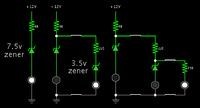Sopetard666
Newbie level 3

I need help with a circuit I haven't been able to find one like it
so any way I'll have to describe it
I'm trying to wire a model train so
when it reverses it has a led to light the way
but when I add a auxiliary tender it is block
so I'm trying to add a led to the aux tender
but I don't want the first led on when the second one is
I also have a second aux tender I use too
so I also don't want the first two LED's on when the third one is
Does anyone know how to wire this circuit or make a circuit diagram like this?
so any way I'll have to describe it
I'm trying to wire a model train so
when it reverses it has a led to light the way
but when I add a auxiliary tender it is block
so I'm trying to add a led to the aux tender
but I don't want the first led on when the second one is
I also have a second aux tender I use too
so I also don't want the first two LED's on when the third one is
Does anyone know how to wire this circuit or make a circuit diagram like this?




